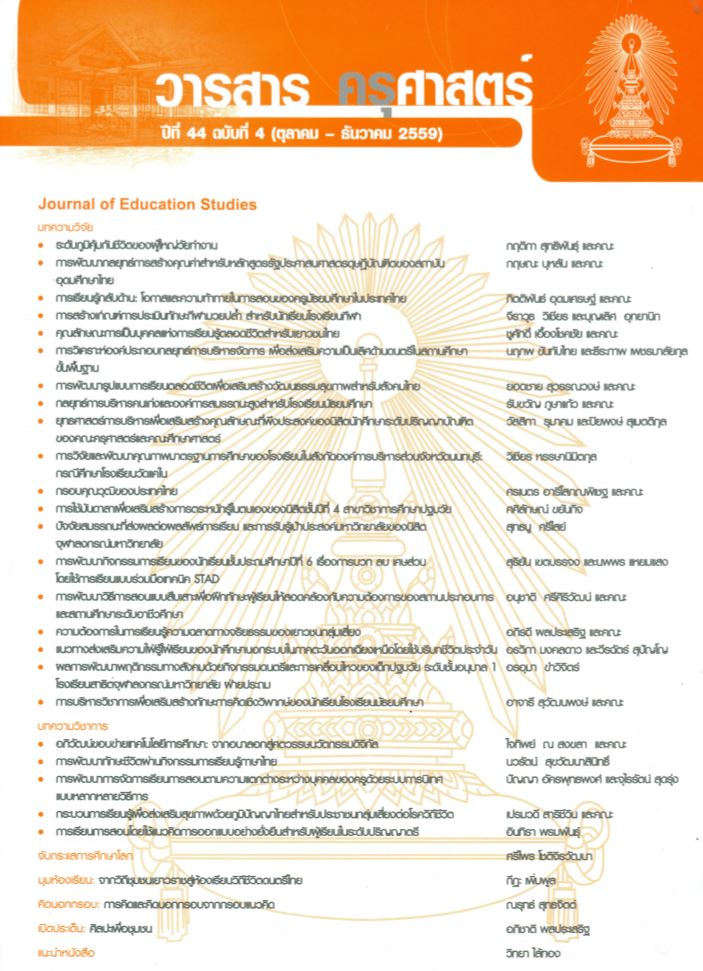ปัจจัยสมรรถนะที่ส่งผลต่อผลลัพธ์การเรียน และการรับรู้เป้าประสงค์มหาวิทยาลัย ของนิสิตจุฬาลงกรณ์มหาวิทยาลัย
คำสำคัญ:
สมรรถนะ, ผลลัพธ์การเรียน, การรับรู้, เป้าประสงค์, จุฬาลงกรณ์มหาวิทยาลัย, Competency, Learning Outcomes, Perception, Overview, Chulalongkorn Universityบทคัดย่อ
การวิจัยครั้งนี้มีวัตถุประสงค์หลักเพื่อวิเคราะห์องค์ประกอบเชิงยืนยันและศึกษาความสัมพันธ์เชิงเหตุผลปัจจัยสมรรถนะที่ส่งผลต่อผลลัพธ์การเรียนและการรับรู้เป้าประสงค์จุฬาฯ ของนิสิต ข้อมูลจากแบบสอบถามที่มีคุณภาพ (สัมประสิทธิ์ความเที่ยงแบบอัลฟ่าทั้งฉบับเป็น 0.952) ของนิสิต 10 คณะ จำนวน 216 คนถูกวิเคราะห์ด้วยค่าสถิติ One-sample t-test การวิเคราะห์องค์ประกอบเชิงยืนยัน และ การวิเคราะห์เส้นทางด้วยโปรแกรม LISREL ผลการวิจัยเป็นดังนี้ 1) ในภาพรวม มี 1 ใน 4 ปัจจัยสมรรถนะของนิสิตอยู่ในระดับสูง (Mean 70% และ P < .05) คือ ทัศนคติต่อการเรียน ส่วนสมรรถนะด้านทักษะการปฏิบัติงาน และ พฤติกรรมการเรียน อยู่ในระดับปานกลาง และ สมรรถนะด้านการจัดการความอยู่ในระดับต่ำ ขณะเดียวกันพบว่า ปัจจัยผลลัพธ์การเรียน และ การรับรู้เป้าประสงค์มหาวิทยาลัยของนิสิตอยู่ในระดับสูง (P < .05) 2) องค์ประกอบเชิงยืนยันพบว่า ในด้านพฤติกรรมการเรียนมี 2 ใน 3 องค์ประกอบสำคัญ ด้านทัศนคติต่อการเรียนมี 2 ใน 3 องค์ประกอบสำคัญ ด้านการจัดการความรู้มี 4 ใน 6 องค์ประกอบสำคัญ ด้านทักษะการปฏิบัติงานมี 1 ใน 5 องค์ประกอบสำคัญ และ ผลลัพธ์การเรียนมี 2 ใน 3 องค์ประกอบสำคัญ ตามลำดับ ส่วนการรับรู้เป้าประสงค์มหาวิทยาลัยของนิสิต ไม่มีองค์ประกอบใดเป็นองค์ประกอบสำคัญอย่างชัดเจน และ 3) ความสัมพันธ์เชิงเหตุผล พบว่า แบบจำลองมีความสอดคล้องกับข้อมูลเชิงประจักษ์ มีค่าสถิติคือ Chi-Square = 309.16, df = 288, P-Value = .18711, RMSEA = 0.039 สรุปได้ว่า แบบจำลองมีความเหมาะสม สามารถอธิบายความสัมพันธ์เชิงเหตุผลได้ดังนี้ 3.1) ผลลัพธ์การเรียนของนิสิต ได้รับอิทธิพลโดยตรงมาจากสมรรถนะด้านทักษะการปฏิบัติ และ ทัศนคติต่อการเรียน ในระดับต่ำ ขณะเดียวกันได้รับอิทธิพลทางอ้อมมาจากพฤติกรรมการเรียน ทัศนคติต่อการเรียน และ การจัดการความรู้ โดยส่งผ่านด้านการจัดการความรู้ และ/หรือ ทักษะการปฏิบัติของนิสิตในระดับต่ำ เช่นเดียวกัน นอกจากนี้ยังพบว่า ปัจจัยทั้งสี่ดังกล่าวสามารถทำนายผลลัพธ์การเรียนของนิสิตได้ร้อยละ 6.50 (P >.05) และ 3.2) การรับรู้เป้าประสงค์มหาวิทยาลัยของนิสิต ได้รับอิทธิพลโดยตรงระดับต่ำทุกปัจจัยมาจาก สมรรถนะด้านทัศนคติต่อการเรียน ทักษะการปฏิบัติงาน พฤติกรรมการเรียน และ การจัดการความรู้ และได้รับอิทธิพลทางอ้อมในระดับต่ำมาจากพฤติกรรมการเรียน การจัดการความรู้ และ ทัศนคติต่อการเรียน โดยส่งผ่านทักษะการปฏิบัติงาน และ/หรือ การจัดการความรู้ นอกจากนี้ยังพบว่า ปัจจัยทั้งหมดดังกล่าวสามารถทำนายการรับรู้เป้าประสงค์มหาวิทยาลัยของนิสิตจุฬาฯ ได้ร้อยละ 65.50 อย่างมีนัยสำคัญที่ระดับ .05
The main objectives of this study were to analyze the confirmatory factors and to examine the causal relationships among competency factors that affect students’ learning outcomes and perception on the overview (CU strategies 2012-2016 or CU-pillar) of Chulalongkorn University. Data from a set of 216 student questionnaires (Alpha-reliability coefficient = 0.952) from 10 faculties were analyzed by one-sample t-test, confirmatory factor analysis and path analysis using the LISREL program. The research findings were as follows: 1) For the overall student competency, 1 of 4 components was at the high level (70% up and P < .05), namely learning attitudes. Moreover, 2 of 4 components were at the moderate level, namely practical skills and learning behaviors. Only one component was at the low level- knowledge management. Also, it revealed that both students’ learning outcomes and their perception of the CU-pillar were at the high level (P < .05); 2). As for the confirmatory factor analysis, the following aspects were the crucial components: 2 of 3 components for the learning behaviors aspect, 2 of 3 components for the learning attitudes aspect, 4 of 6 components for the knowledge management aspect, 1 of 5 component for the practical skills aspect, and 2 of 3 components for the learning outcomes aspect. Also, no crucial components were clearly found in terms of students’ CU-Pillar perception; 3) For the causal analysis with the model, it was found that data were relevant and fit the model, the statistics for Chi-Square = 309.16, df = 288, P-Value = .18711, RMSEA = 0.039. Also, it was concluded that the model is likely appropriate and can be explained as follows: 3.1) Students’ learning outcomes were directly effected by the 2 competency components, namely practical skills and learning attitudes, at the low level. Moreover, it was also indirectly effected by the 3 competency components of learning behaviors, learning attitude, and knowledge management through students’ competency components of knowledge management and/or practical skills at the same low level. It was also found that those 4 aspects could predict the students’ learning outcomes at 6.50 percent (P >.05); 3.2). For the students’ perception of the CU-pillar of Chulalongkorn University, most of them showed a low level of positive direct effects from all of the competency components of learning attitudes, practical skills, learning behaviors, and knowledge management. Moreover, they were indirectly effected at the same low level from learning behaviors, knowledge management, and learning attitudes through practical skills and/or knowledge management. It was also found that all competency components could predict students’ perception of the CU-pillar at 65.50 percent and at the .05 level of significance.




